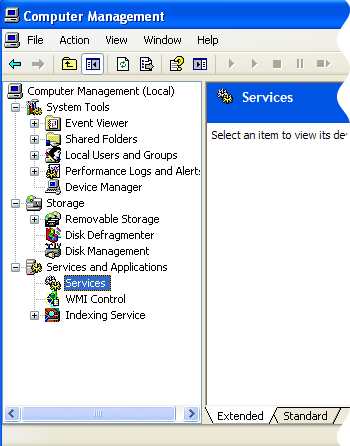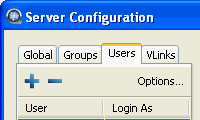Follow the steps below to set up a remote transfer-server node for IBM Aspera Faspex.
-
Set up the Node API.
The Node API must be set up in IBM Aspera Faspex for Faspex to communicate with the remote machine. Refer to the Node API Setup section in the Managing the Node API section of the IBM Aspera Enterprise Server Administrator's Guide for instructions on how to set up the Node API in Enterprise Server.
-
Create the system user "faspex".
This is the user who authenticates the actual ascp transfer, and must be an operating system account. To create a new system user "faspex" on your Windows system, go to Control Panel > User Accounts. After adding the faspex user, change the user's password.
-
Create and configure the faspex package directory.
Create the following directory:
C:\faspex_packages
-
Configure aspera.conf.
Add the faspex package directory as a docroot in aspera.conf. The aspera.conf file can be found in the following location:
OS Version File Location 32-bit Windows C:\Program Files\Aspera\Enterprise Server\etc\aspera.conf 64-bit Windows C:\Program Files (x86)\Aspera\Enterprise Server\etc\aspera.conf Below is a typical Faspex aspera.conf file. Yours may differ, particularly if you have installed other Aspera products. Modify the following, as necessary:
- In the file below, look for the <absolute> tag to see how the docroot has been defined in this installation, and adjust yours accordingly.
- Look for the <server_name> tag below, and ensure that SERVER_IP_OR_NAME has been replaced with the name or IP address of your server.
- In the <central_server> section, set <persistent_store> to enable as shown below. Faspex 3.5+ requires persistent storage to be enabled. By default, <persistent_store> is disabled (not set).
<?xml version='1.0' encoding='UTF-8'?> <CONF version="2"> <central_server> <address>127.0.0.1</address> <port>40001</port> <compact_on_startup>enable</compact_on_startup> <persistent_store>enable</persistent_store> <persistent_store_on_error>ignore</persistent_store_on_error> <persistent_store_max_age>86400</persistent_store_max_age> <event_buffer_overrun>block</event_buffer_overrun> </central_server> <default> <file_system> <pre_calculate_job_size>yes</pre_calculate_job_size> </file_system> </default> <aaa> <realms> <realm> <users> <user> <name>faspex</name> <file_system> <access> <paths> <path> <absolute>C:\faspex_packages</absolute> <show_as>/</show_as> <dir_allowed>true</dir_allowed> </path> </paths> </access> <directory_create_mode>770</directory_create_mode> <file_create_mode>660</file_create_mode> </file_system> <authorization> <transfer> <in> <value>token</value> </in> <out> <value>token</value> </out> </transfer> <token> <encryption_key>af208360-dbdd-4033-a35b-2370941f37e9</encryption_key> </token> </authorization> </user> </users> </realm> </realms> </aaa> <http_server> <http_port>8080</http_port> <enable_http>1</enable_http> <https_port>8443</https_port> <enable_https>1</enable_https> </http_server> <server> <server_name>SERVER_IP_OR_NAME</server_name> </server> </CONF>After modifying aspera.conf, restart Aspera Central and Aspera NodeD services.
You can restart these services from the Windows Computer Management window, accessible from Manage > Services and Applications > Services.

-
Add the faspex user to your Aspera server.
Launch the IBM Aspera Enterprise Server application (Start menu > All Programs > Aspera > Enterprise Server > Enterprise Server) and click Configuration.
Within Server Configuration, select the Users tab and click the
 button.
button.
-
Verify you have installed a valid license on your transfer server.
If you need to update your transfer server license (by following the instructions in the Updating Product License section of the Enterprise Server Admin Guide), you must reload the asperanoded service afterwards. Reload the asperanoded service by running asnodeadmin.exe, found in the following location:
OS Version File Location 32-bit Windows C:\Program Files\Aspera\Enterprise Server\bin\asnodeadmin.exe 64-bit Windows C:\Program Files (x86)\Aspera\Enterprise Server\bin\asnodeadmin.exe > asnodeadmin.exe --reload
-
Set up the node user.
Run the following commands to set up the node user (where "node-admin" is the node user, "s3cur3_p433" is his password and "faspex" is the system user), and then reload asperanoded.
> asnodeadmin.exe -a -u node-admin -p s3cur3_p433 -x faspex > asnodeadmin.exe --reload
-
Install the IBM Aspera Connect Browser Plug-in key.
First, locate your Connect Browser Plug-in key as follows:
OS Version File Location 32-bit Windows C:\Program Files\Aspera\Enterprise Server\var\aspera_id_dsa.pub
64-bit Windows C:\Program Files (x86)\Aspera\Enterprise Server\var\aspera_id_dsa.pub
Then, run the following commands in a terminal window to create a .ssh folder (if it does not already exist) in the faspex user's home directory:> cd "C:\Documents and Settings\faspex" > md .ssh
Use a text editor to create (or edit) the following file, without the file extension:C:\Documents and Settings\faspex\.ssh\authorized_keys
Add the faspex user's key string into this file and save it.Note: Some text editors add a .txt extension to the filename automatically. Be sure to remove the extension if it was added to the filename. -
Configure your remote transfer server in the Faspex
Web GUI.
Follow the instructions in the topic "Configuring a Remote Server in Faspex for configuring your remote transfer server in the Faspex Web GUI (Server > File Storage).